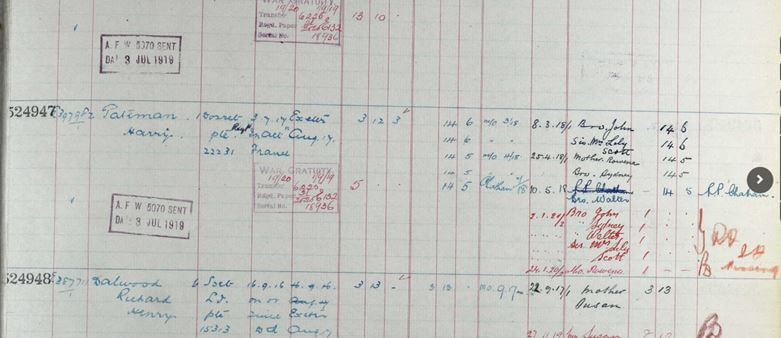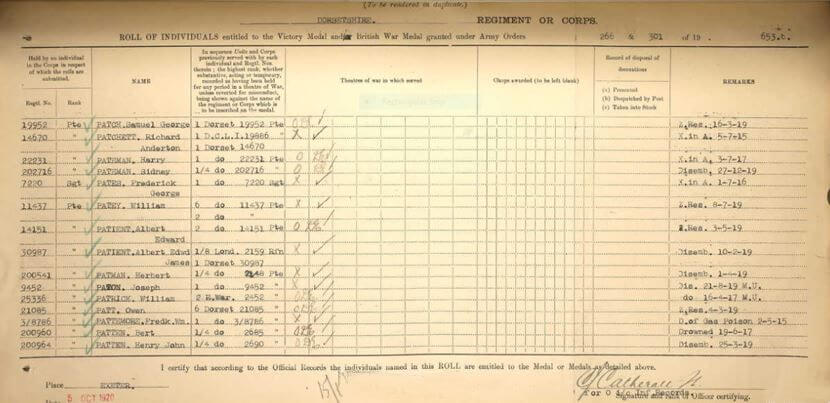Harry Pateman
W.W.1.
1882 to 1917
Born: 1882 in Thorney Hill, Bransgore
Residence: Fleet, Hants
Death Date: 3 Jul 1917
Death Place: Died in action France and Flanders
Enlistment Place:Winchester, Hants
Rank: Private
Regiment: Dorsetshire Regiment
Battalion: 1st Battalion
Regimental Number: 22231
Theatre of War: Western European Theatre
Hampshire Regiment.Memorial in Bransgore.Son of John Pateman and Rowena Louisa Pateman (nee Corbin) Harry lived in Fleet when he enlisted into Winchester Hampshire’s in mid 1916. It is thought he probably joined one of the Hampshire Battalions in France before the end of 1916. There is no date given on his medal roll for his arrival in France.
To be transferred to the Dorset’s he would have had to be evacuated back to England either wounded or ill, as such forced transfers between regiments were sometimes effected at infantry training depot at Etaples when troops returned to France. It is not known when Harry joined his new unit, but the 1st Dorset’s had started 1917 on the Ancre, where the main enemy was the intense cold.

Part of 95th brigade in 32nd division, Harry’s battalion was relieved towards the end of February and marched to the right of the British line as it was taking over French trenches at Le Quesnil.
On March 14th it became clear that the Germans had begun their planned withdrawal to the Hindenburg line. Officer’s chargers were ordered forward and on the 18th the Battalion began the pursuit, but the Germans devastated the country, set booby traps and conducted a fighting withdrawal.
April 2nd the Dorsets had to put in a set piece attack on Holnon and on the 13th assaulted St Quentin. A day later they were ordered at short notice to occupy Cepy Farm in support of a renewed attack on St Quentin. With no support the Dorsets immediately rushed the farm and took it. None of these actions incurred large losses that would have made the transfer of other regiment’s soldiery necessary.
Two days later their division was transferred north to Nieuport. The troops arrived by bush and were billeted in a hutted camp amongst the sand dunes. The sector was quiet, and the men enjoyed bathing. The Dorsets took over their line at Nieuport on 17th June from a battalion on the 3rd French regiment.
Harry and his mates marched up through Nieuport and across the pontoon bridges over the Yser Canal to get to the line. Because of the water level from the deliberate flooding of the Yser, there were no trenches, but the troops sheltered behind massive barricades which were not always bullet proof.
On the 20th the Dorsets were subjected to a gas attack. The heavy rain dispersed the gas quickly and there were no casualties. On the 21st and 22nd heavy shelling caused the battalion to have 3 killed and 33 wounded, before they went into support the following day, then on the 25th, into reserve.
Two days later the men moved to Rivaillet Camp to be nearer the brigade. Although in reserve they provided working parties for the front, on one of which 2 officers and 6 soldiers were wounded. The Germans had air superiority at this time and any effort to strengthen the defenses brought immediate retaliation.

On the evening of 1st July the battalion moved into the line again, taking over from 2nd Manchester’s in d sub sector. The war diary records.
Harry was one of the two soldiers killed by the shelling on 3rd July. He is buried in Nieuport Communal Cemetery in grave 1.
